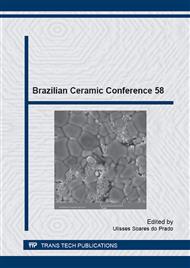p.564
p.570
p.576
p.583
p.588
p.594
p.600
p.605
p.609
Assessment of the Addition of Electric Arc Furnace Dust in Hot Metal at Temperature of 1,350 °C
Abstract:
This research aims to assess the incorporation of mass of the electric arc furnace dust (EAFD) by addition in hot metal produced in a local foundry (1.78% Si) at a temperature of 1,350°C. The EAFD is from a steel mill producer of long steel. The EAFD was added in the form of briquettes. Previously, the EAFD was characterized using the following techniques: chemical analysis, size analysis, X-ray diffraction, scanning electron microscopy (SEM) and Energy Dispersive Spectroscopy (EDS) microanalysis. The achievement of fusion experiments in laboratory scale, took place in a vertical tubular furnace with temperature control. The fusion experiments to assess the incorporation of the EAFD mass used alumina crucibles. A flow of inert gas (argon) was maintained inside the furnace during the experiments. After cooling the furnace to room temperature, it was done the pig iron and the slag were weighed to do a mass balance to assess the efficiency of the experiments.
Info:
Periodical:
Pages:
588-593
Citation:
Online since:
June 2015
Keywords:
Price:
Сopyright:
© 2015 Trans Tech Publications Ltd. All Rights Reserved
Share:
Citation:


